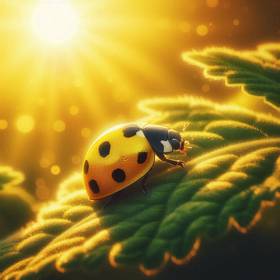
Do Ladybugs Bite Humans?
Ladybugs, those charming little beetles with their bright colors, are generally considered harmless to humans. While they do possess mouthparts designed for chewing aphids and other soft-bodied insects, their bites on humans are extremely rare and unlikely to cause significant harm.
Ladybugs primarily use their mouthparts to pierce and consume their prey. They might resort to biting a human if they feel threatened, are handled roughly, or perhaps mistake skin for a food source if they are particularly hungry. However, such a bite is typically more of a gentle pinch than a painful sting.
If you do happen to experience a ladybug bite, it is likely to be a minor irritation that will disappear quickly. The best course of action is to simply wash the area with soap and water. If there's any slight discomfort, a cold compress can be applied.
Most Common Biting Ladybug Species
Asian Lady Beetle (Harmonia axyridis)
The Asian Lady Beetle (Harmonia axyridis) is a small, dome-shaped beetle, typically measuring 5-8 millimeters in length. They are highly variable in color, ranging from bright orange to red, and can have many, few, or no black markings. A key identifier for this species is often a white "M" or "W" shaped marking on their pronotum (the shield-like plate behind the head). This invasive species has become a common sight in many parts of the world and is known for its voracious appetite for aphids and other insect pests. While beneficial for pest control, they are also the ladybug species most commonly associated with biting humans, especially when they congregate indoors in large numbers during cooler months.
Seven-spotted Ladybug (Coccinella septempunctata)
The Seven-spotted Ladybug (Coccinella septempunctata) is a well-known species, measuring about 5-8 millimeters in length. Its bright red body is characteristically adorned with three black spots on each wing cover (elytra), plus one spot in the center where the elytra meet, totaling seven spots. Its head is black with white markings. This species is common in gardens and fields throughout Europe and North America. While primarily beneficial aphid predators, they can occasionally nip if handled, though they are generally less aggressive than the Asian Lady Beetle.
Multicolored Asian Lady Beetle (Harmonia axyridis)
This is another name for the Asian Lady Beetle (Harmonia axyridis), emphasizing its wide range of color variations. As mentioned above, it's a small, dome-shaped beetle, typically 5-8 millimeters long. Its color can vary from tan or orange to bright red, and it may have numerous black spots, few spots, or no spots at all. The distinctive white marking on the pronotum (often resembling an "M" or "W") is a more reliable identifier. This species is known for congregating in homes during fall and winter and is more prone to defensive biting than many native ladybug species.
How to Identify Biting Ladybugs
Physical Characteristics to Look For
Biting ladybugs, primarily the Asian Lady Beetle (Harmonia axyridis), can be identified by a few key characteristics. They are typically 5-8 millimeters long and dome-shaped. Their coloration is highly variable, ranging from tan or orange to deep red. They may have many black spots, a few, or none at all. A more consistent feature is the pronotum (the area behind the head), which often has a white or pale marking resembling an "M" or "W". While native ladybugs also vary, the Asian Lady Beetle's tendency to invade homes in large numbers in the fall is a strong indicator.
Behavioral Signs of Aggressive Ladybugs
While most ladybugs are docile, certain behaviors can indicate a higher likelihood of a nip, especially from species like the Asian Lady Beetle. If a ladybug feels threatened, it might:
- Display defensive posturing: This can include raising its legs or body slightly.
- Secrete a yellowish fluid (hemolymph): This is a defensive chemical that has a foul odor and can stain surfaces. This "reflex bleeding" is a sign of stress or agitation.
- Be more active or agitated: Especially when confined or when trying to find an exit if trapped indoors.
- Congregate in large numbers: While not a direct sign of individual aggression, large groups indoors (common with Asian Lady Beetles in fall) increase the chance of accidental contact and defensive bites.
Seasonal Patterns and Biting Risk
The risk of encountering biting ladybugs, particularly Asian Lady Beetles, shows distinct seasonal patterns.
- Spring and Summer: Ladybugs are active outdoors, feeding on aphids and reproducing. Bites are less common as they are dispersed and focused on feeding.
- Late Summer to Fall: As temperatures cool and daylight hours shorten (typically September to November), Asian Lady Beetles begin seeking overwintering sites. This is when they are most likely to enter homes in large numbers, often congregating on sunny sides of buildings. The increased indoor presence and potential for being disturbed raises the risk of bites.
- Winter: Ladybugs that have found shelter indoors may become active on warmer days. If disturbed from their resting places, they might bite.
- Early Spring: Overwintering ladybugs become active again, seeking to move outdoors. Encounters and potential bites can occur as they try to exit homes.

Understanding Ladybug Bites
Why Do Ladybugs Bite?
Ladybugs rarely bite humans. Their primary diet consists of aphids and other soft-bodied insects, which they consume using their chewing mouthparts. A ladybug might bite a human for a few reasons:
- Defense: If a ladybug feels threatened, trapped, or is handled roughly, it may bite as a last resort.
- Exploration/Hunger: Occasionally, particularly if food sources are scarce or if a ladybug is exploring a new surface, it might "test bite" human skin. This is more common with the Asian Lady Beetle.
- Seeking Moisture/Salts: Some insects are attracted to moisture or salts on human skin, which could lead to an exploratory nip.
Bite Symptoms and Reactions
While ladybug bites are rare and generally harmless, they can happen if the beetle feels threatened. The sensation is often described as a minor pinch or prick. Common symptoms include:
- A tiny red mark at the site of the bite.
- Mild, localized itching or irritation.
- Slight swelling in some cases.
Allergic Reactions to Ladybug Bites »»
Difference Between Harmful and Harmless Species' Bites
While most native ladybug species are extremely unlikely to bite humans, the Asian Lady Beetle (Harmonia axyridis) is the species most often implicated in biting incidents. There isn't a significant difference in the *physical* nature of the bite itself if a native ladybug were to bite versus an Asian Lady Beetle – both would be minor nips.
The key differences lie in:
- Frequency of Biting: Asian Lady Beetles are more prone to biting defensively or exploratorily, especially when they are indoors in large numbers or are disturbed. Native species are far more reclusive and less likely to be in situations where they would bite a human.
- Associated Reactions: Asian Lady Beetles can also cause mild allergic reactions in some sensitive individuals, not just from bites but also from their presence (e.g., through inhalation of airborne particles if infestations are heavy) or from contact with their defensive fluid (hemolymph). This is less commonly associated with native ladybugs.
- Nuisance Factor: Asian Lady Beetles are considered a nuisance pest due to their tendency to invade homes in large numbers, their foul odor when crushed, and their potential to stain surfaces with their yellow hemolymph. These factors, combined with their higher propensity to bite, make encounters with them more problematic than with generally harmless native species.
FAQs About Biting Ladybugs
1. Do all ladybugs bite?
No, not all ladybugs bite. Most native species are harmless and very unlikely to bite unless severely provoked. The species most commonly associated with biting is the Multicolored Asian Lady Beetle (Harmonia axyridis).
2. What type of ladybug is most likely to bite?
The Multicolored Asian Lady Beetle (Harmonia axyridis) is the species best known for its occasional biting behavior. They are more aggressive than many native ladybugs, especially when they congregate indoors or feel threatened.
3. How can I tell if a ladybug is likely to bite?
It's difficult to predict with certainty. However, Asian Lady Beetles are more prone to biting. Look for the "M" or "W" shaped white marking on the pronotum (behind the head). If a ladybug appears agitated, is part of a large indoor congregation, or is handled roughly, the chance of a defensive nip increases.
4. What does a ladybug bite feel like and what are the symptoms?
A ladybug bite usually feels like a small pinch or a tiny prick. Symptoms are typically very mild and may include a small red mark, slight itching, or minor irritation at the bite site. These symptoms usually disappear quickly.
5. Are ladybug bites dangerous or venomous?
No, ladybug bites are not dangerous or venomous. They do not transmit diseases. The main concern is minor discomfort or, in rare cases, a mild allergic reaction to the ladybug itself (not specifically the bite) in sensitive individuals, particularly with Asian Lady Beetles.